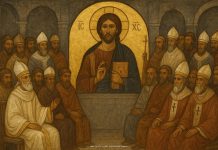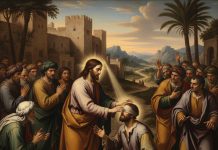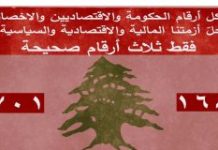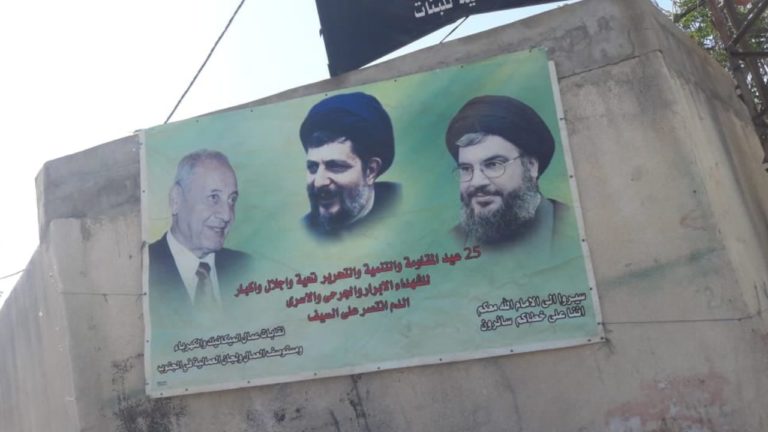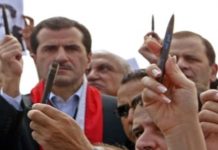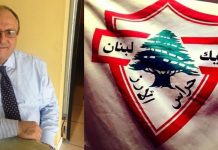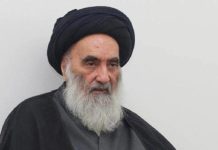When Will Lebanese Shiites Expel the “Temple Traders”?
Hussein Ataya/Janoubia/October 17/2024
متى يطرد اللبنانيون الشيعة «تجار الهيكل»؟!/حقائق تتناول مواقف ومخططات الإمام موسى الصدر
حسين عطايا /جنوبية/17 تشرين الأول/2024
منذ ان اتى الإمام موسى الصدر الى لبنان، وبدأ في السعي والعمل لإنشاء مؤسسة شيعية مذهبية، بدأت معه رواية الشيعة المحرومين والشيعة “العتالين” على مرفأ بيروت، وغيرها من القصص والروايات المختلقة، لإجتذاب عامة الشيعة في الجنوب والبقاع الشمالي خاصة، لان مثقفي ومتعلمي الشيعة كانوا في مكانٍ اخر، كانوا بمعظمهم قوميين عرب ويساريين، وبعضهم الاخر تقليديين مع الزعامات الشيعية التقليدية، كآل حمادة في البقاع، وآل الاسعد في الجنوب، وآل صفي الدين وآل الخليل في صور، وآل الزين في منطقة النبطية، وغيرهم من العائلات التي لها حيثية في كافة المناطق، التي يقطن فيها اللبنانيون الشيعة.
مشروع ايراني
اتى موسى الصدر ومعه مشروعٍ إيراني بزمن الشاه، فكان يتحدث بمواضيع ظاهرها لبناني ينادي بنهائية لبنان، بينما كان يعمل على تأسيس حركة المحرومين، بعد ان اسس المجلس الشيعي الاعلى واستتب له الامر، وايضا بدأ بتأسيس افواج المقاومة أمل، وهي الجناح العسكري لحركة المحرومين امل، ولولا انفجار لغم ارضي اثناء التدريب وذهب ضحيته عشرات القتلى، لما كان اعترف بالامر واعلن عنه ، وهذه الافواج كان تمويلها وتدريبها على ايدي ضباط في “حركة فتح”، وبدعمٍ رئيسها من “ابوعمار ومن ثم رئيس منظمة التحرير الفلسطينية، وأبان الحرب الاهلية تعاون مع الفلسطينيين “ابوعمار” والليبيين معمر القذافي، ومع بدء حركة الثورة في ايران حاول، ان يتعاون مع ملالي ايران، وهنا كانت سقطته، حيث تم اكتشاف تعاونه مع الشاه، وهذا ما سبب بمقتله في ليبيا في تلك الزيارة المشؤومة في اواخر شهر اب ١٩٧٨. من هنا، كانت بداية التجارة باللبنانيين الشيعة وفي السعي لمذهبتهم، بعد ان كانوا الاكثر بعداً عن الطائفية والمذهبية في لبنان فيما مضى، واتت فيما بعد متغيرات الدخول السوري، والالاعيب التي قام بها النظام في استيعاب “حركة امل” برئاسة نبيه بري، ووضعها بكنفه وبحمايته، وكلنا يعلم احداث بيروت والجنوب ومشاكل “امل” مع احزاب الحركة الوطنية اللبنانية، ومن ثم الثورة الفلسطينية حتى دخول الاحتلال الصهيوني في العام ١٩٨٢، وما جرى من ممارسات “مشبوهة”.
على الرغم من ان المقاومة الوطنية “جمول”، كان في عِدادها مجموعات تنتمي للطائفة الشيعية، لكن انتمائها السياسي يساري لاحزاب الحركة الوطنية، مع قلة قليلة من المناضلين الشرفاء، كامثال محمد سعد وخليل جرادي ورفاقهما من “امل”، ومعهم مجموعات مناضلة من الحركة، شاركوا بمقاومة الاحتلال منذ اليوم الاول، وكانوا جنباً الى جنب مع مقاومي “جمول” . ثم اتت اعمال الصراع الشيعي الشيعي، والذي هو انعكاس لصراع سوري ايراني، دفع ثمنه الآلاف من ابناء الطائفة الشيعية على مذبح الجلجلة، في قتال الاخوة لصالح سوريا وايران، الى ان تمت المصالحة وتم تقاسم الجبنة الطائفية، بين “امل” و”حزب الله” وحتى اعمال المقاومة تم حصرها في الحزب، بعد ان تمت عمليات تصفية لمقاومي ومناضلي “جمول” على يد اتباع “امل” و”حزب الله”، واستشهد غِيلة خيرة مقاومي ومفكري اليسار و”جمول”، في الفترة ما بين العامي ١٩٨٦ و١٩٨٧، وانتهت “جمول”، وتمرد “حزب الله” حتى تم منع جماعة امل من المقاومة.
وتمت السيطرة ل”حزب الله” بمقاومة إسلامية مذهبية تحولت بعد العام ٢٠٠٠، الى قوة ايرانية خارجة عن سيطرة الدولة والواقع اللبناني، حيث تغولت واصبحت دويلة ضمن الدولة، وخاضت حروب كثيرة شرع بعضها الرئيس رفيق الحريري، والذي قُتل اغتيالاً على ايدي عناصر من مقاومة “حزب الله”، وفقاً لقرارات المحكمة الدولية الخاصة بلبنان.
ومن هنا اصبح “حزب الله” ومقاومته يحتكران قراري الحرب والسلم، اصبحت الدولة اللبنانية شاهد زور، بعد ان تمكن من اخضاعها الحزب بالتهديد والوعيد، بدءاً من ٧ ايار عام ٢٠٠٨، وغزوته المشهورة لمدينة بيروت عاصمة لبنان، وحينها اطلق مقولته المشهورة امين عام حزب الله الراحل السيد حسن نصرالله ، مخاطباً انصاره بأن يوم السابع من ايار يوم اجتياح بيروت كان “يوماً مجيداً” في تاريخ المقاومة، ومن وقتها بدأ بشعاره الجديد “يا أشرف الناس” ، مخاطبا اتباعه وجماهير حزبه، وهنا قد بدأ بتصنيف اللبنانيين بين اشرف الناس وهم اتباعه، وارذلهم هم ممن لا يُدينون له بالولاء. احتكار السلطة والفساد
اما المجلس الاسلامي الشيعي الاعلى الذي اسسه موسى الصدر، اصبح اداة طيعة بين ايدي “امل” و”حزب الله”، وهنا يشاهد المواطن الشيعي كيف تُنفق اموال الخمس والزكاة، وعائدات الجامعة الاسلامية ومستشفى الزهراء، على ايدي المنتفعين والمحاسيب والازلام، المنتمين لاتباع “حزب الله” و”حركة امل”، وكيف ان الفساد يعشعش من اعلى الهرم الى اسفله بالمجلس المذكور، وكيف ان اموال ابناء الطائفة، تُهدر على امور سيئة ولا يستفيد منها ابناء او فقراء الطائفة الشيعية، عداك عن الاقساط المرتفعة في الجامعة الاسلامية، وبدلات الاستشفاء الكبيرة التي يتكبدها المرضى والمحتاجين، وعلى اسرة مستشفى الزهراء.
وتأتي حروب “حزب الله” في الاعوام ١٩٩٣ و١٩٩٦ و٢٠٠٦ والحرب الحالية ٢٠٢٣، والمستمرة ليومنا هذا، حيث يجري تدمير كل ما بناه ابناء الطائفة الشيعية على مر العقود والسنين، ليذهب هباءاً منثورا على يد “حزب الله”، وذلك ليس من اجل لبنان والشيعة من ابنائه، بل كرمى لعيون الولي الفقيه في ايران ومشروعه النووي، والذي يدفع ابناء الطائفة الشيعية في لبنان ثمناً باهظا من دم ابنائهم وعرق جبينهم، الذي يذهب بلحظات وكأنه لم يكن.
اما رئيس المجلس الشيعي الاعلى الشيخ علي الخطيب، فيحضر اللقاءات والابتسامة العريضة لاتفارق ثغره، وهو هرب من مبنى المجلس في الضاحية الى قصر المجلس في الحازمية، متمتعاً بكل اساليب الراحة، بينما ابناء وفقراء الطائفة الشيعية، يبيتون على الارصفة والشوارع في بيروت وبقية المناطق، دون مأوى وحتى دون غطاء. هذه احوال الشيعة اللبنانيين، المبتلين بقيادات اقل ما يقال فيها عميلة تفتقر الى حس المسؤولية، تجاه ابناء طائفتهم والذين يحتكرون تمثيلهم، ويحصرون وكالتهم بهما وهم منهم براء ومن تصرفاتهم واعمالهم. الى متى سيبقى ابناء الطائفة الشيعية والذين كانوا مثالاً بالوطنية، وفي مقدمة المناضلين للتغيير في لبنان صامتين مستكينين، وابنائهم يموتون قتلاً على الطرقات الخطأ وفي المعارك الخطأ، وتُدمر ارزاقهم وممتلكاتهم امام اعينهم، وهم صامتون صمت ابوالهول في الوادي العظيم.
فإلى ذالك اليوم، ننتظر حيث سيهب ابناء الطائفة الشيعية، منتفضين على من تسيدوا القيادة واحتكروها، ليُعيدوا الحق لمن يستحقه، ويعود الشيعة عربوبيين لبنانيين، ويقودون عملية التغيير الوطني للبنان، افضل متطور، يعتز به ابناؤه امام كل العالم.
When Will Lebanese Shiites Expel the “Temple Traders”?
By Hussein Ataya /Janoubia/October 17/2024
(Free Translation by LCCC website editor & publisher)
Since Imam Musa al-Sadr arrived in Lebanon and began working to establish a sectarian Shiite institution, the narrative of the deprived Shiites and the laboring Shiites at the Port of Beirut began to take shape. These stories were largely fabricated to attract the Shiite masses, particularly in southern Lebanon and the northern Bekaa Valley, as most educated and intellectual Shiites belonged to other groups. They were either Arab nationalists, leftists, or affiliated with traditional Shiite families such as the Hamada family in Bekaa, the Asaad family in the South, the Safi al-Din and Khalil families in Tyre, the Zain family in Nabatieh, and others who held prominent positions across regions inhabited by Lebanese Shiites.
An Iranian Project
Musa al-Sadr came with an Iranian project under the Shah’s rule. Although he spoke on Lebanese issues, calling for Lebanon’s finality as a state, he was actually working to establish the “Movement of the Deprived” after founding the Supreme Islamic Shiite Council. He also began forming the armed wing of the Movement, known as the Amal Movement, which served as its military wing. The existence of this militia was only revealed after a landmine exploded during training, killing dozens. This militia was funded and trained by officers from the “Fatah” movement, with support from its leader Yasser Arafat, and the Palestinian Liberation Organization (PLO). During the Lebanese Civil War, al-Sadr cooperated with Arafat, Muammar Gaddafi of Libya, and later attempted to collaborate with the Iranian Mullahs during the Iranian revolution. This, however, led to his downfall when his cooperation with the Shah was exposed, leading to his murder in Libya during his infamous trip in August 1978.
This marked the beginning of the manipulation of Lebanese Shiites and the effort to sectarianize them, despite Shiites previously being among the least sectarian groups in Lebanon. Following the Syrian intervention and the regime’s manipulation of the Amal Movement under Nabih Berri, Amal became firmly under Syrian protection. We all remember the events in Beirut and southern Lebanon and the conflicts between Amal and the Lebanese National Movement, as well as the Palestinian revolutionaries, until the Israeli invasion in 1982, which saw dubious practices unfold.
Hezbollah’s Emergence
Although the Lebanese National Resistance Front (Jammoul) included groups from the Shiite community, these were politically aligned with leftist parties, with only a few exceptions like the honorable fighters Mohammad Saad, Khalil Jaradi, and their comrades from Amal, who resisted the occupation from day one. These groups fought alongside Jammoul’s resistance. However, the intra-Shiite conflict emerged, reflecting the Syrian-Iranian rivalry, which claimed the lives of thousands of Shiites in fratricidal battles fought for Syria and Iran’s interests. The conflict eventually led to a reconciliation and a division of sectarian power between Amal and Hezbollah. The resistance efforts were later monopolized by Hezbollah, and Jammoul’s fighters were eliminated by both Amal and Hezbollah between 1986 and 1987, marking the end of Jammoul and leaving Hezbollah in control of all resistance activities. Hezbollah, empowered after 2000, transformed into an Iranian force outside the control of the Lebanese state, becoming a state within a state, fighting several wars, some of which were endorsed by Rafik Hariri. However, Hariri was later assassinated by Hezbollah operatives, as confirmed by the Special Tribunal for Lebanon.
From this point onward, Hezbollah monopolized the decisions of war and peace, and the Lebanese state became a mere witness, unable to act under Hezbollah’s threats. This began with the infamous May 7, 2008, invasion of Beirut, during which Hezbollah’s Secretary General, Hassan Nasrallah, called it a “glorious day” in the history of the resistance. From then on, Nasrallah began addressing his followers as “the most honorable people,” classifying the Lebanese as either those who supported him or those who did not, whom he regarded with disdain.
Power Monopoly and Corruption
The Supreme Islamic Shiite Council, founded by Musa al-Sadr, became a tool in the hands of Amal and Hezbollah. Shiite citizens now see how their religious taxes (khums) and donations (zakat), along with the revenues from the Islamic University and Al-Zahraa Hospital, are squandered by the cronies of Amal and Hezbollah, benefiting only a select few while the rest of the Shiite community, including the poor, receive no benefit. This corruption runs from the top of the council to the bottom, with resources being wasted on inappropriate matters. University tuition fees and hospital charges remain high, burdening the community, while the leaders live comfortably.
Hezbollah’s wars in 1993, 1996, 2006, and now in 2023—ongoing at this very moment—have destroyed everything built by the Shiite community over decades. This devastation is not for Lebanon or its Shiite citizens, but to serve the interests of the Iranian Supreme Leader and Iran’s nuclear ambitions, for which the Lebanese Shiites are paying a heavy price in blood and lost livelihoods.
Meanwhile, the head of the Supreme Shiite Council, Sheikh Ali al-Khatib, smiles broadly during meetings, having fled the council’s headquarters in Dahieh to its luxurious offices in Hazmieh, enjoying all comforts while the Shiite poor sleep on the streets without shelter or blankets. This is the reality of the Lebanese Shiites today, suffering under leaders who, at best, can be described as treasonous, lacking any sense of responsibility toward their community, which they falsely claim to represent.
Time for Change
How long will the Lebanese Shiites, once known for their patriotism and leadership in the fight for change, remain silent while their children die in futile wars, their properties are destroyed before their eyes, and they stand silent like the Sphinx? We await the day when the Shiite community rises to reclaim its leadership from those who have monopolized it, restoring their Arab-Lebanese identity and leading the national movement for a better Lebanon, respected by its people and admired worldwide.





